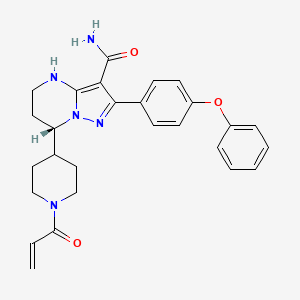



1. (7s)-2-(4-phenoxyphenyl)-7-(1-(prop-2-enoyl)piperidin-4-yl)-4,5,6,7-tetrahydropyrazolo(1,5-a)pyrimidine-3-carboxamide
2. 7-(1-acryloyl-4-piperidinyl)-2-(4-phenoxyphenyl)-4,5,6,7-tetrahydropyrazolo(1,5-a)pyrimidine-3-carboxamide
3. Bgb-3111
4. Brukinsa
1. 1691249-45-2
2. Brukinsa
3. Bgb-3111
4. Zanubrutinib [inn]
5. Zanubrutinib [usan]
6. Ag9mhg098z
7. 1691249-45-2 (s-isomer)
8. (7s)-2-(4-phenoxyphenyl)-7-(1-(prop-2-enoyl)piperidin-4-yl)-4,5,6,7-tetrahydropyrazolo(1,5-a)pyrimidine-3-carboxamide
9. Bgb3111
10. (7s)-2-(4-phenoxyphenyl)-7-(1-prop-2-enoylpiperidin-4-yl)-4,5,6,7-tetrahydropyrazolo[1,5-a]pyrimidine-3-carboxamide
11. (7s)-4,5,6,7-tetrahydro-7-[1-(1-oxo-2-propen-1-yl)-4-piperidinyl]-2-(4-phenoxyphenyl)pyrazolo[1,5-a]pyrimidine-3-carboxamide
12. (s)-7-(1-acryloylpiperidin-4-yl)-2-(4-phenoxyphenyl)-4,5,6,7-tetrahydropyrazolo[1,5-a]pyrimidine-3-carboxamide
13. Pyrazolo(1,5-a)pyrimidine-3-carboxamide, 4,5,6,7-tetrahydro-7-(1-(1-oxo-2-propen-1-yl)-4-piperidinyl)-2-(4-phenoxyphenyl)-, (7s)-
14. Brukinsa (tn)
15. Zanubrutinib [mi]
16. Zanubrutinib (usan/inn)
17. Zanubrutinib [usan:inn]
18. Unii-ag9mhg098z
19. Bgb-3111(zanubrutinib)
20. Zanubrutinib (bgb-3111)
21. Zanubrutinib [who-dd]
22. Gtpl9861
23. Chembl3936761
24. Schembl17842597
25. Bdbm250082
26. Dtxsid701026208
27. Zanubrutinib [orange Book]
28. Compound 27b [us9447106]
29. Bcp29110
30. Ex-a3602
31. Nsc823807
32. S8791
33. Zinc584641430
34. At18252
35. Db15035
36. Hy-101474a
37. Nsc-823807
38. Us9447106, 27b (peak 2)
39. Bs-15529
40. Bz168474
41. Cs-0021869
42. D11422
43. Bgb-3111; Bgb 3111; Bgb3111
44. A934931
45. 1651179-04-2
46. 7-(1-acryloyl-4-piperidinyl)-2-(4-phenoxyphenyl)-4,5,6,7-tetrahydropyrazolo(1,5-a)pyrimidine-3-carboxamide
| Molecular Weight | 471.5 g/mol |
|---|---|
| Molecular Formula | C27H29N5O3 |
| XLogP3 | 3.5 |
| Hydrogen Bond Donor Count | 2 |
| Hydrogen Bond Acceptor Count | 5 |
| Rotatable Bond Count | 6 |
| Exact Mass | 471.22703980 g/mol |
| Monoisotopic Mass | 471.22703980 g/mol |
| Topological Polar Surface Area | 103 Ų |
| Heavy Atom Count | 35 |
| Formal Charge | 0 |
| Complexity | 756 |
| Isotope Atom Count | 0 |
| Defined Atom Stereocenter Count | 1 |
| Undefined Atom Stereocenter Count | 0 |
| Defined Bond Stereocenter Count | 0 |
| Undefined Bond Stereocenter Count | 0 |
| Covalently Bonded Unit Count | 1 |
Zanubrutinib is indicated for the treatment of adult patients with mantle cell lymphoma (MCL) who have received at least one prior therapy. It is used to treat Waldenstrms macroglobulinemia in adults. Zanubrutinib is also indicated for the treatment of relapsed or refractory marginal zone lymphoma (MZL) in adults who have received at least one anti-CD20-based regimen.
Brukinsa as monotherapy is indicated for the treatment of adult patients with Waldenstrms macroglobulinaemia (WM) who have received at least one prior therapy, or in first line treatment for patients unsuitable for chemo-immunotherapy.
Zanubrutinib is an immunomodulating agent that decreases the survival of malignant B cells. It inhibits BTK by binding to its active site. It works to inhibit the proliferation and survival of malignant B cells to reduce the tumour size in mantle cell lymphoma.
Antineoplastic Agents
Substances that inhibit or prevent the proliferation of NEOPLASMS. (See all compounds classified as Antineoplastic Agents.)
Hematologic Agents
Drugs that act on blood and blood-forming organs and those that affect the hemostatic system. (See all compounds classified as Hematologic Agents.)
Protein Kinase Inhibitors
Agents that inhibit PROTEIN KINASES. (See all compounds classified as Protein Kinase Inhibitors.)
L01
L - Antineoplastic and immunomodulating agents
L01 - Antineoplastic agents
L01E - Protein kinase inhibitors
L01EL - Bruton's tyrosine kinase (btk) inhibitors
L01EL03 - Zanubrutinib
Absorption
Following oral administration of zanubrutinib 160 mg twice daily and 320 mg once daily, the mean (%CV) zanubrutinib steady-state concentrations were 2,295 (37%) ngh/mL and 2,180 (41%) ngh/mL, respectively. The mean Cmax (%CV) was 314 (46%) ng/mL following 160 mg twice daily and 543 (51%) ng/mL following 320 mg once daily. The Cmax and AUC of zanubrutinib increase in a dose-proportional manner and there is minimal systemic accumulation after repeated dosing. The median Tmax is 2 hours.
Route of Elimination
Following oral administration of 320 mg radiolabelled zanubrutinib, approximately 87% of the dose was excreted in the feces and about 8% of the dose was recovered in the urine, where less than 1% of the recovered drug comprised of unchanged parent drug.
Volume of Distribution
The geometric mean (%CV) apparent steady-state Vd is 881 (95%) L. The blood-to plasma ratio is about 0.7 to 0.8.
Clearance
The mean (%CV) apparent oral clearance (CL/F) of zanubrutinib is 182 (37%) L/h.
Zanubrutinib is predominantly metabolized by CYP3A4. Its metabolites have not been characterized.
Following administration of a single oral dose of 160 mg or 320 mg of zanubrutinib, the mean half-life is approximately 2 to 4 hours.
Bruton's tyrosine kinase (BTK) is a non-receptor kinase and a signalling molecule for the B cell receptors expressed on the peripheral B cell surface. The BCR signalling pathway plays a crucial role in normal B-cell development but also the proliferation and survival of malignant B cells in many B cell malignancies, including mantle-cell lymphoma (MCL). Once activated by upstream Src-family kinases, BTK phosphorylates phospholipase-C (PLC), leading to Ca2+ mobilization and activation of NF-B and MAP kinase pathways. These downstream cascades promote the expression of genes involved in B cell proliferation and survival. The BCR signalling pathway also induces the anti-apoptotic protein Bcl-xL and regulates the integrin 41 (VLA-4)-mediated adhesion of B cells to vascular cell adhesion molecule-1 (VCAM-1) and fibronectin via BTK. Apart from the direct downstream signal transduction pathway of B cells, BTK is also involved in chemokine receptor, Toll-like receptor (TLR) and Fc receptor signalling pathways. Zanubrutinib inhibits BTK by forming a covalent bond with cysteine 481 residue in the adenosine triphosphate (ATP)binding pocket of BTK, which is the enzyme's active site. This binding specificity is commonly seen with other BTK inhibitors. Due to this binding profile, zanubrutinib may also bind with varying affinities to related and unrelated ATP-binding kinases that possess a cysteine residue at this position. By blocking the BCR signalling pathway, zanubrutinib inhibits the proliferation, trafficking, chemotaxis, and adhesion of malignant B cells, ultimately leading to reduced tumour size. Zanubrutinib was also shown to downregulate programmed death-ligand 1 (PD-1) expression and cytotoxic T lymphocyte-associated antigen-4 (CTLA-4) on CD4+ T cells.